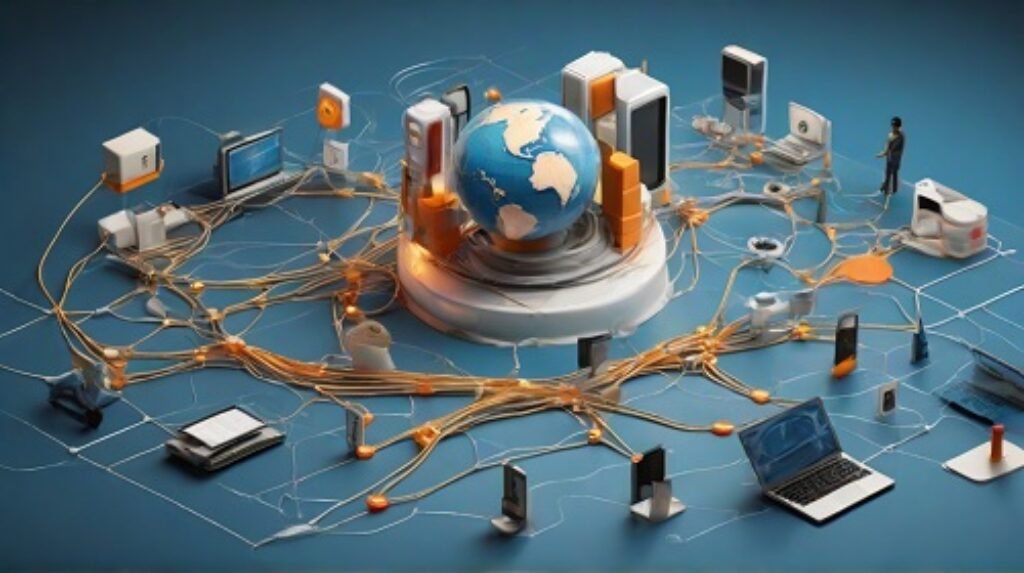Welcome to our article on the Internet of Things (IoT)! In today’s interconnected world, IoT has become an integral part of our daily lives, revolutionizing the way we interact with technology. But what exactly is IoT and how does it work?
IoT refers to a network of interconnected devices that exchange data with each other and the cloud. Because of the sensors and software built into these devices, they can gather and process environmental data. The data can inform decisions and automate operations.
From a person wearing a heart monitor implant to a smart car with built-in sensors, IoT devices can be found in a wide range of industries. They collect, send, and act on data, creating a seamless ecosystem of connected devices.
By leveraging IoT technology, businesses can gain real-time insights, improve operational efficiency, and enhance customer service. IoT enables automation, streamlining processes, and reducing costs. It also opens up new opportunities for innovation and growth.
Now that we have a basic understanding of IoT, let’s dive deeper into how it works and explore its applications across different industries.
Key Takeaways:
- IoT refers to a network of interconnected devices that exchange data.
- These devices have software and sensors for collecting and analysing data.
- IoT enables real-time insights, automation, and improved operational efficiency.
- It has diverse applications across industries, from healthcare to agriculture.
- IoT presents both advantages, such as increased accessibility, and challenges, such as cybersecurity risks.
How Does IoT Work?
In order to understand how the Internet of Things works, it is important to first explore its infrastructure and the devices involved. IoT infrastructure consists of interconnected devices that communicate with each other and exchange data. These devices can range from sensors and actuators to smart appliances and wearables. They are able to gather and send data because they are embedded with sensors, software, and communication hardware.
IoT devices
Sensors on devices collect data from their surroundings and send it to an Internet of Things gateway. The gateway functions as the main hub for processing and collecting data. Before transmitting the data to the cloud or a remote server, it can be analyzed locally by edge devices. This local analysis reduces bandwidth consumption and allows for real-time decision-making at the device or gateway level.
communication protocols
IoT communication protocols play a crucial role in facilitating seamless data exchange between devices. These protocols ensure that IoT devices can communicate and interact with each other effectively. Some commonly used IoT communication protocols include MQTT, CoAP, and HTTP. These protocols enable secure and efficient data transmission in IoT ecosystems.
In addition to its infrastructure and communication protocols, IoT can also leverage artificial intelligence and machine learning. AI and machine learning algorithms can automate operations, optimise energy use, and increase predictive analytics in the IoT ecosystem. These technologies empower devices to learn from data, make intelligent decisions, and adapt to changing environments.

Example of IoT Communication Protocol: MQTT
One example of an IoT communication protocol is MQTT (Message Queuing Telemetry Transport). MQTT is a simple messaging system based on publish-subscribe that is made to work in limited spaces. It is used a lot in IoT apps because it requires little power and bandwidth.
| MQTT Protocol | Description |
| Publish-Subscribe Model | MQTT follows a publish-subscribe model, where devices can publish messages to topics and other devices can subscribe to those topics to receive the messages. |
| QoS Levels | MQTT supports different Quality of Service (QoS) levels, ranging from “At most once” to “Exactly once,” allowing for varying degrees of reliability and delivery guarantees. |
| Lightweight | MQTT is designed to be lightweight, making it suitable for resource-constrained devices such as sensors and microcontrollers. |
| Low Bandwidth and Power Requirements | Since MQTT uses a lightweight protocol, it consumes minimal bandwidth and power, making it ideal for low-power IoT devices. |
“IoT devices rely on communication protocols like MQTT to ensure seamless data exchange between different devices in an IoT ecosystem. These protocols enable devices to publish and subscribe to topics, allowing for efficient and reliable communication.”
Why is IoT Important?
The Internet of Things, plays a crucial role in various industries, offering numerous benefits and applications. Let’s explore why IoT is important and how it impacts different sectors.
Benefits of IoT
It brings several advantages to organizations, enabling them to enhance operations and improve overall efficiency. Some key benefits of IoT include:
- Monitoring and Automation: IoT allows businesses to monitor their processes in real time, enabling proactive decision-making. It also facilitates automation, eliminating manual tasks and improving productivity.
- Customer Experience: By leveraging IoT, companies can provide personalized and seamless experiences to their customers. For example, in retail, IoT devices can track consumer behavior and preferences to deliver tailored recommendations.
- Cost and Time Savings: IoT helps streamline operations, reduce resource wastage, and optimize energy consumption. This leads to significant cost savings and improved sustainability.
- Data-driven Insights: The vast amount of data collected by these devices enables organizations to gain valuable insights. By analyzing this data, businesses can make informed decisions and identify areas for improvement.
Applications of IoT in Different Industries
Many applications in various sectors, revolutionizing the way operations are conducted. Here are a few examples of IoT in different industries:
| Industry | Applications |
| Agriculture | IoT sensors can monitor soil moisture levels, weather conditions, and crop health, allowing farmers to optimize irrigation and increase crop yields. |
| Healthcare | IoT devices enable remote patient monitoring, real-time health data tracking, and drug management systems, improving patient care and reducing hospital readmissions. |
| Manufacturing | IoT enables predictive maintenance, inventory tracking, and supply chain optimization, leading to increased operational efficiency and reduced downtime. |
| Sustainability | Smart cities leverage IoT to monitor energy consumption, optimize waste management systems, and enhance overall environmental sustainability. |
These are just a few examples of how IoT is transforming industries. Its potential for innovation and improvement is vast, making it an essential technology for organizations to stay competitive in the digital age. By harnessing the power of IoT, businesses can unlock new opportunities and achieve significant growth.
Pros and Cons of IoT
The Internet of Things, offers several advantages that have made it a revolutionary technology in various industries. One of the key advantages is the easy accessibility to information on any device and from anywhere. With IoT, users can connect and interact with their devices remotely, enabling greater convenience and control over their surroundings.
Another advantage of IoT is the improved communication between devices. IoT devices can seamlessly exchange data and collaborate, enabling efficient coordination and automation of tasks. This leads to better services and enhanced productivity.
One of the main strengths of IoT is its ability to collect, transfer, and analyze large amounts of data. This allows organizations to gain valuable insights and make informed decisions based on real-time information. It opens up opportunities for predictive analysis and proactive problem-solving.
“IoT enables organizations to increase efficiency, automate processes, and enhance decision-making.”
However, despite its numerous advantages, IoT also has its drawbacks. One of the major concerns is the increased risk of cyber attacks. As more devices become connected, the potential attack surface expands, making IoT systems vulnerable to security breaches and unauthorized access.
Device management
Device management is another challenge associated with IoT. With the proliferation of IoT devices, organizations need to manage and maintain a large number of interconnected devices. Ensuring compatibility between different devices and managing software updates can be complex and resource-intensive.
Despite these challenges, the advantages of IoT outweigh the disadvantages. As technology continues to evolve and security measures improve, IoT has the potential to revolutionize industries and improve the quality of life for individuals by leveraging the power of interconnected devices and data analysis.
| Advantages of IoT | Disadvantages of IoT |
| Easy accessibility to information on any device and from anywhere | Increased risk of cyber attacks |
| Improved communication between devices | Device management challenges as the number of IoT devices grows |
| Efficient data transfer, collection, and analysis | Potential system vulnerabilities |
| Automation of tasks leading to better services | Compatibility issues between devices |
| Continuous healthcare monitoring |
Conclusion
The Internet of Things (IoT) is a revolutionary technology that has transformed the way we connect and exchange data between devices. By understanding The Internet of Things and harnessing its power, organizations can unlock a world of opportunities to improve their business processes and drive growth.
However, it is important to be aware of the potential challenges and security risks associated with IoT. As the number of IoT devices grows, there is a heightened risk of cyber-attacks and device management challenges. It is crucial to implement robust security measures and stay updated with the latest IoT technologies to mitigate these risks.
In conclusion, the Internet of Things has the potential to transform industries and improve the quality of life for individuals. By embracing IoT and understanding its benefits, organizations can stay ahead of the curve and unlock new levels of success. The future of connectivity lies in the power of IoT and its ability to harness the potential of interconnected devices and data analysis.
FAQ
What is the Internet of Things (IoT)?
The Internet of Things (IoT) refers to a network of interconnected devices that can exchange data with each other and the cloud. Devices are embedded with technology such as sensors and software.
How does The Internet of Things work?
Devices collect data from sensors and use communication hardware to send that data to an IoT gateway. This gateway serves as a central hub for devices to share their data. This data can be transferred to the cloud for additional analysis, or it can be examined locally.
What are the benefits of The Internet of Things?
It allows for monitoring of business processes, improves customer experience, saves time and money, enhances employee productivity, enables flexible business models, and facilitates better decision-making.
What are the advantages of using IoT?
The Internet of Things offers easy accessibility to information on any device and from anywhere, improved communication between devices, efficient data transfer, collection and analysis of large amounts of data, automation of tasks leading to better services, and continuous healthcare monitoring.
Are there any disadvantages to using The Internet of Things?
Yes, there are potential challenges such as the increased risk of cyber attacks, device management challenges as the number of IoT devices grows, potential system vulnerabilities, and compatibility issues between devices.
What are the applications of The Internet of Things?
It has diverse applications, from agriculture and home automation to healthcare, finance, and manufacturing. It can be used in farming, infrastructure monitoring, home automation, smart cities, and many other industries.
Why is IoT important?
It is important because it improves business processes, provides real-time insights, enables automation, increases productivity, efficiency, and revenue for organizations, and has the potential to transform industries and improve the quality of life for individuals.
How can AI and machine learning be used in The Internet of Things?
AI and machine learning can simplify the data collection process in IoT and make it more dynamic. They can analyze data, identify patterns, and make predictions, leading to more efficient and intelligent decision-making.
Learn more about Smart Home Automation
Source Links:


